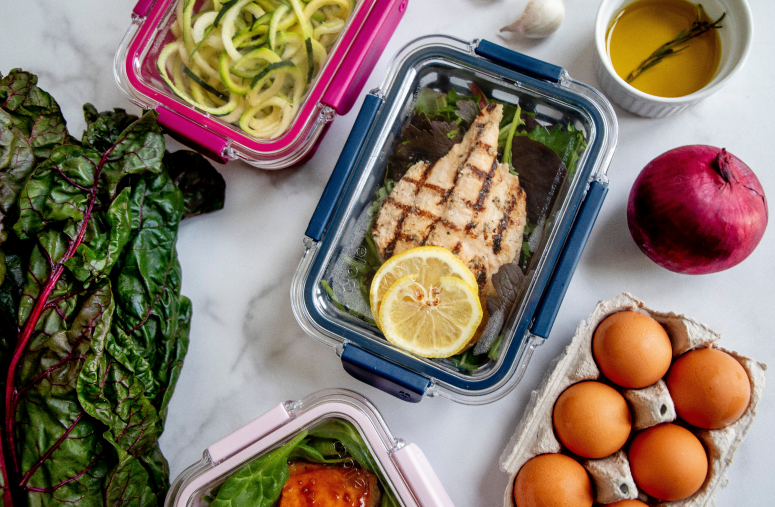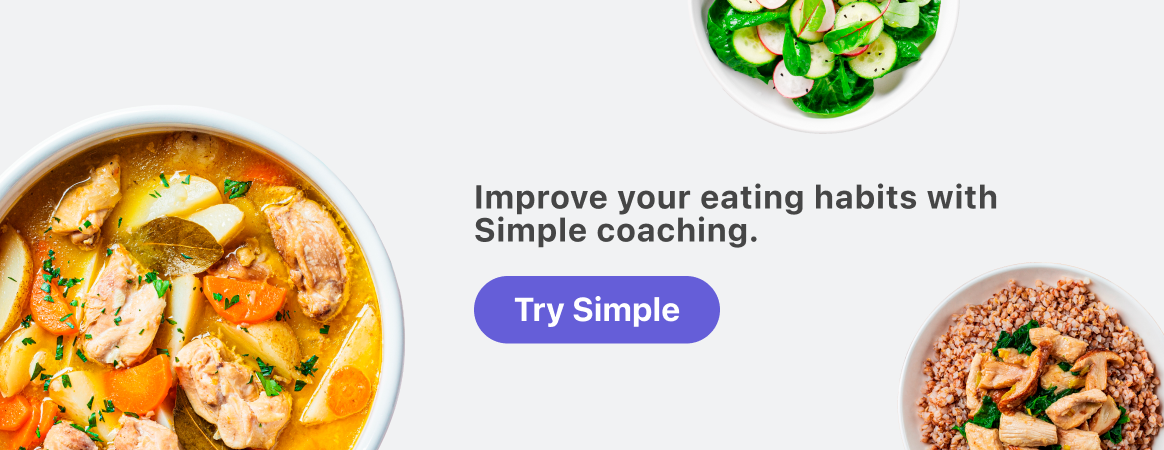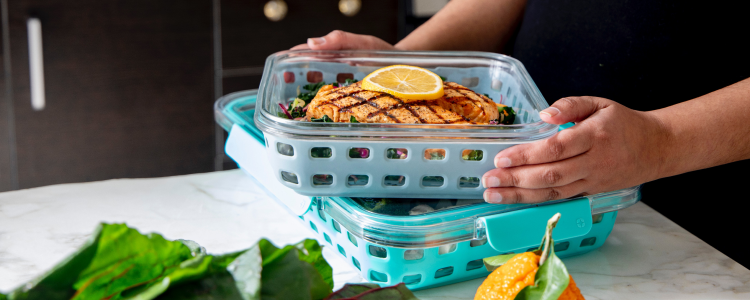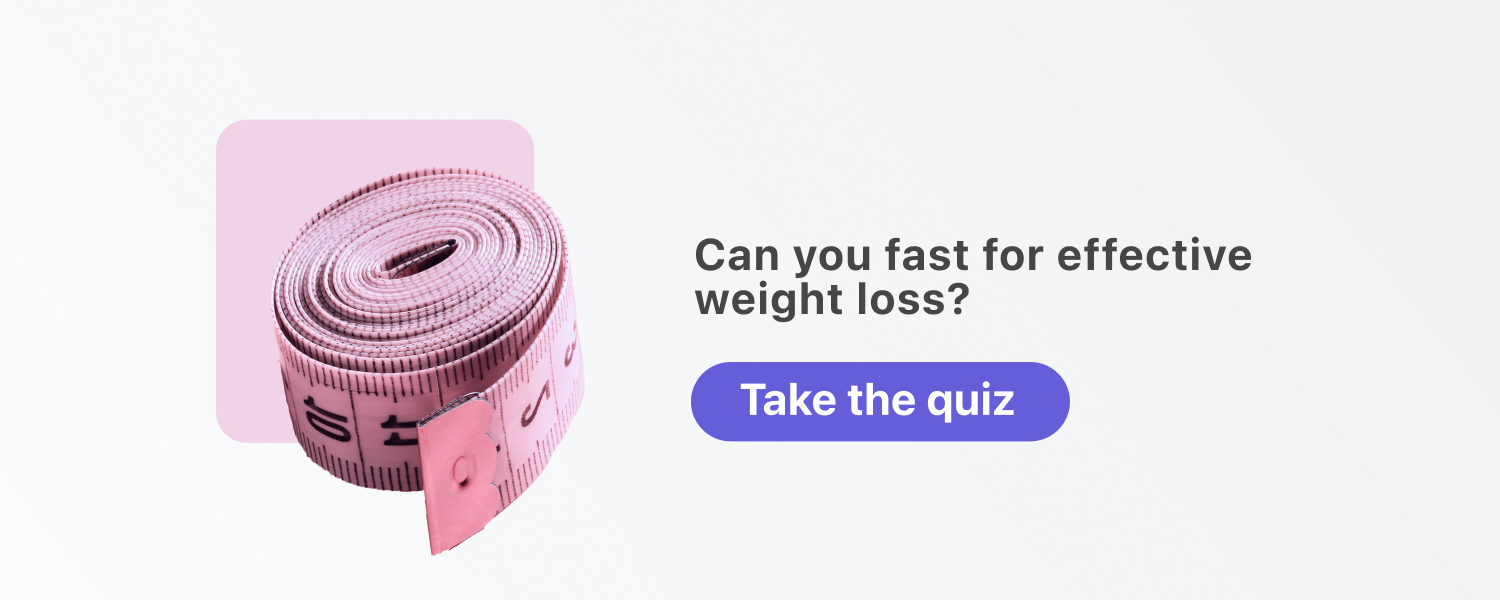Intermittent fasting and meal planning — explained by Simple

One of THE most important habits for positively changing your nutrition is the unassuming but often-challenging habit of …
[drum roll]
… meal planning.
This holds true for any way we might approach our eating. Whether you’re going keto, paleo, low carb, etc., meal planning is fundamental to success.

If you’re into intermittent fasting, it’s no different. To make sure you get all the nutrients, energy, and enjoyment you need from your food, you gotta meal plan.
Fear not, we’re here to show you how!

How to schedule meals when you are intermittent fasting
There are lots of ways to schedule your meals throughout your day. Maybe you’re a “three square meals a day” person or more of the little-and-often, six-meals-a-day type. It’s all good.
When you’re meal planning to support your intermittent fasting, all options are on the table.
The thing is, life can often be a little … skittish. Hard to pin down. A day you had thoughtfully planned can turn into a clown show of epic proportions, and then all the wheels come off.
So, when thinking about scheduling your meals, there are two super important steps.
- Plan your ideal schedule
Our suggestion would be to space your meals and snacks evenly throughout your eating window. So, if you’re following a 16:8 intermittent fasting schedule, you’ve got eight hours to play with. That could look something like this:
8 AM: breakfast
10 AM: snack
12 PM: lunch
2 PM: snack
3:30 PM: dinner
- Have a plan B
But, for those days the clown show is in town, you need a backup. Let’s run through a couple of scenarios where having a plan B comes into play.
Scenario #1: Your dog is sick all over the hallway at 7:59 AM, and because you gotta clean that up, now you’re outta time for breakfast. What’s your backup? What can you grab and go?
Scenario #2: Your boss dumps more work on you at 11:45 AM, and the deadline is shorter than hitting snooze on your alarm clock feels. Now your lunch is dead in the water. What do you do? Could you grab a big glass of H20 to tide you over, then hit lunch and your snack in that 2 PM slot? Essentially, if you stay ready, you ain’t gotta get ready. Your ideal schedule will work some of the time but not all the time, and your backup plan will be what keeps you in the game.
The importance of nutrition while intermittent fasting

When you’re intermittent fasting, getting enough food in is crucial, both from a nutrient-sufficiency POV and for making sure you don’t turn into a Hangry Monster a few days down the line.
Let’s talk more about that. What makes nutrition (and therefore meal planning) so important while intermittent fasting?
We need enough micronutrients
Micronutrients are the vitamins, minerals, and phytonutrients we find in foods that support us in all sorts of cool ways, like helping us see in the dark (thanks, vitamin A), making our bones strong (calcium for the win), and propping up our immune system, so we don’t get sick (yeah zinc, selenium, and iron!!).
Without these little guys, we wouldn’t grow, develop, recover from injury, or have functioning internal organs — they really punch above their weight.
We need enough macronutrients
In a very small nutshell, and missing out on all the salient details, here are some of each macronutrient’s starring roles in our bodies:
- Protein makes our muscles, hair, and skin.
- Carbs fuel both our bodies and our brains.
- Fats are literally what our cells are made of.
- Veggies and fruits bring micronutrients to the party (see above).
When fasting, because our eating window is shorter, we run a higher risk of nutrient deficiencies from undereating.
That means we need to make more effort to ensure we get enough micro- and macronutrients.
Eating helps us manage our hunger and cravings
What you do during your eating windows will determine whether your fasts put you on the struggle bus or have you gliding along on cruise control.
If you eat mostly healthy, nutrient-dense, high-quality foods, your appetite will be easier to manage. Your hunger will be better satisfied, and your cravings will be calmer and fewer.
If you eat mostly processed, nutrient-poor, refined foods, you can expect that hunger will come a-knocking more often and more strongly, and your cravings will get loud and persistent.
You’ve got goals to hit
Paying attention to the quality of your nutrition is the difference between doing intermittent fasting and hitting your goals vs. doing intermittent fasting and nothing changing for you or your body.
For insulin sensitivity to increase, blood pressure to drop, and cholesterol levels to improve — all these outcomes rely on solid, healthy nutrition.
Quality fuel in the tank helps everything run more smoothly.
Speaking of your goals, how about getting some support in your corner? Take our Simple quiz, and we’ll be the coach in your pocket, full of ideas, recipes, and encouragement to help you achieve your goals. You can use our app to track your food, drink, and fasts, and we’ll remind you to do the things (so long as you switch on the notifications, of course. We don’t want to bug you).
What can I eat on an intermittent fasting meal plan?
Let’s get out of the whys and into the whats.
What can you eat on an intermittent fasting meal plan? Everything’s on the table here, but as we’ve just talked about, some foods will get you better results than others.
An intermittent fasting meal plan that drives results will contain the following:
- lean protein
- whole grains
- veggies and fruits
- healthy fats
- calcium-rich foods
Plus, it’ll seek to minimize the intake of ultra-processed foods, refined carbohydrates, and unhealthy fats.
OK. But what does that mean in terms of actual foods? To get down into the nitty gritty with us, check out our “What to eat during intermittent fasting” guide, where we’ll teach you the top 10 foods to eat during intermittent fasting and some to steer clear of, too.
Beginner meal plans for every intermittent fasting schedule

If you’re already into intermittent fasting, you’ve got your schedule in place, and you’re ready to wrap your head around how to meal plan.
(If you haven’t started yet, our intermittent fasting for beginners guide can help.)
Time-restricted eating (TRE)
Whichever TRE schedule you’re following, whether, 18:6, 16:8, 14:10, or 12:12, your job is to fit all the nourishment you need into your eating window.
How might you spread your food out kinda evenly over two to four meals and 1–2 snacks?
Here’s how a six-hour window might look:
- 12 PM: veggie baked omelet
- 2:30 PM: blueberry-coconut smoothie
- 5:30 PM: tuna tacos
An eight-hour window could be:
- 8 AM: strawberry avocado breakfast smoothie
- 12 PM: high-protein vegetarian white chili
- 2:30 PM: apple + handful of nuts and seeds
- 5:30 PM: turkey patties with sweet potato wedges
The 5:2 diet
The 5:2 diet means you’ve got five days of eating however much you need and two days that are restricted to 500/600 calories.
That means that you’re in for two days of pretty hefty calorie restriction, so heads up: we don’t recommend this fasting schedule unless your healthcare team is on board. It’s always important to consult them before making any significant changes to your eating routine, but their support is especially critical if you’re going to attempt a more restrictive fasting schedule.
That includes getting their input and advice on a suitable meal plan, too. But here are some general guidelines so you have an idea of what you’ll be working with.
On those two fasting days, your meal plan needs to contain foods that a) give you maximum satiety, so they satisfy your hunger for the longest possible time, and b) don’t trigger cravings.
You could space your calories out so that you’re getting a drip feed throughout the day. This can help psychologically. It’s a fact of human nature that we get pleasure from food. Because of that, you might like to take a “little and often” approach to your fasting days because having a small snack to look forward to at periodic intervals throughout the day is helpful.
Or, you might find that this is a recipe for constantly tripping your hunger switch. For some people, the more frequently they eat, the hungrier they feel. If this is you, you may work better eating your 500/600 calories in fewer, larger bouts.
Of course, with 5:2, you need a meal plan for your five non-fasting days as well.
Yeah, we can feel that sense of overwhelm circling, too. Don’t worry. Let’s keep this simple.
Here’s how.
- Start with your current daily menu.
- Identify one change that beefs up the nutritional quality of one meal. For instance, can you add a veggie to your breakfast? Increase the amount of protein you get at lunch? Swap an unhealthy fat for a healthier one?
- Make that change this week. Work on it every day to help it stick.
- Next week, look for another improvement you can make and repeat the process.
When you’re a beginner at intermittent fasting and/or meal planning, it always helps to take it one step at a time.
And remember, you’re not alone in this intermittent fasting and/or meal planning journey! Our app is full of resources, recipes, insights, and support to help you reach your goals. If you’d like to give it a try, you can start by taking our Simple quiz, and we’ll be there to cheer you on every step of the way.
Alternate-day fasting
Alternate-day fasting (ADF) is just like it sounds: every other day, you fast. It’s basically a more intense version of the 5:2 diet: instead of eating only 500/600 calories for two days of any given week, you’re only eating 500/600 calories every other day.
If we don’t recommend the 5:2 diet without medical approval and supervision, you can bet that the same is true for this schedule, too: before you even think about meal planning for ADF, you need the green light from your healthcare team.
Again, you should also work with them to craft a suitable meal plan. But the same vibe works here as with 5:2:
- On fast days, plan foods that work hard to help you manage your appetite, hit your nutritional bases, keep your energy as high as possible, and spread your meals / snacks out however works best for you.
- On non-fast days, the same idea applies, but there’s no need to restrict your calories.
A word about “perfection”
When you’re getting started with something like intermittent fasting and meal planning, it’s very easy to get down on yourself when you don’t do it “perfectly.”
You are going to have days when your attempts to fast are in shambles.
You will eat things that aren’t on your meal plan.
Some days, when your fasting reminder goes off, you’ll internally shake your head like a toddler and shout, “I don’t WANNA!” over and over again. (Some days, this won’t only happen internally. It’s OK. We’ve been there.)
Don’t worry about any of this. It’s part of the process. Any time you find yourself veering somewhat “off-plan”:
- Remember that it happens, and it’s normal.
- Reassure yourself that everything’s OK. All is not lost.
- Wipe the slate clean and get back into it as soon as you’re able.
Creating your own intermittent fasting meal plan

The best meal plan for intermittent fasting is the one that revolves around you.
Yes, we have principles of healthy eating. But we’re betting you already knew those, more or less. We haven’t shaken you awake to a whole new world by saying you need lean protein, veggies, and whole grains.
What matters for creating a kickass meal plan — i.e., one you’ll actually stick to — is taking those principles and translating them into meals you like and want to eat often.
This is the work.
Do not hold yourself hostage to a meal plan full of healthy foods you hate. That’s a road to nowhere.
So ask yourself:
- What lean proteins do you like? Chicken? Lean beef? Fish? Legumes?
- What veggies do you enjoy? Broccoli? Carrots? Peppers?
- What whole grains are you into? Brown rice? Quinoa? Whole wheat pasta? Oats?
- What healthy fats float your boat? Avocado? Nuts and seeds? Olive oil?
- What calcium-rich foods make your body happy? Yogurt? Cottage cheese? Firm tofu?
If you don’t know, or your list of “likes” is quite small right now, that’s OK. This is the time to experiment and explore.
What if you tried one or two new foods a week to expand your repertoire?
Here’s an idea. On a piece of paper, write three headings:
- like / love it
- dislike / hate it
- sometimes OK / sometimes not
Stick it on your fridge door and add foods to it as you try them. You can also use this to:
- weed out foods that you may enjoy but that don’t really like you (for instance, how milk makes you snuffly and Brussels sprouts make you … um … unreasonably gassy)
- record meals and recipes you enjoy
- note foods that always make you overeat or that trigger your cravings
- note foods that satisfy you deeply, which you can eat slowly and mindfully
All of this information equips you to create an intermittent fasting diet that suits you to a tee and meal plan around that.

Intermittent fasting meal planning and weight loss
We’ve covered the key elements of eating healthily, which are crucial if you are doing intermittent fasting for weight and/or fat loss (more info here for the difference between fat loss vs. weight loss).
What else does your meal plan need to take into account?
A few things.
First, you gotta get that protein in.
Sufficient protein helps you lose weight because it keeps you fuller for longer, helps curb your cravings, and is a direct input into preserving and building your muscle mass. The more muscle you have, the more calories you burn during any activity, so it’s a winner for weight loss.
Second, don’t be scared of fat.
Healthy fats work similarly to protein: they help satisfy your appetite and keep cravings under control. Plus, they bring flavor, which is a critical part of enjoying your food.
Just be mindful of your quantities as fats are over twice as calorific as protein (fat has 9 kcals per gram to protein’s 4 kcals per gram).
Third, planning ahead makes consistency easier.
Both research and lived experience show that when we plan things in advance, we’re more likely to do them. As one study shows, writing down when, where, and how we intend to exercise can make it 2–3 times more likely to happen.[1]
The same idea holds true with food. Planning in advance what you intend to eat makes it more likely you’ll follow through with that choice.
And, when you’re trying to lose weight, eating what you intend to eat really matters as it’s often those off-the-cuff, “I’m not feeling motivated today, so I’m just going to grab whatever” food choices that derail your results.
Frequently asked questions about intermittent fasting meal planning
You can eat all the meals during intermittent fasting: breakfast, lunch, and dinner are all good to go, so long as they fit into your eating window!
When you’re in your fasting window, though, park the meals and stick to water, tea, and coffee (and check out our article for the full rundown on what you can drink while fasting).
Some medications break intermittent fasting, but:Taking your meds is more important for your health than fasting. If you are on medication, talk to your doctor before starting intermittent fasting.

